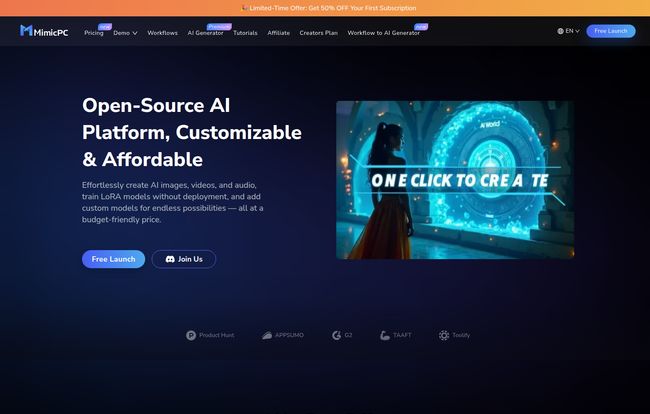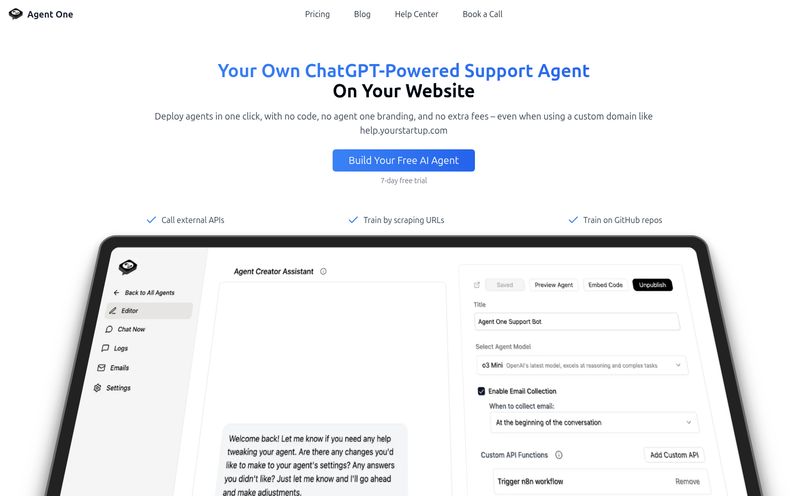The AI space right now feels like a firehose of new tools, all screaming for our attention. Every other day, there's a new 'game-changer' that promises to revolutionize how we create content, generate images, or train models. As someone who’s been in the SEO and traffic generation world for years, I've seen these hype cycles before. But this AI wave… this one feels different. It’s genuinely changing our workflows.
The problem is, who has the time to keep up? Or the technical chops to set up every promising open-source model that drops on GitHub? I've spent more weekend hours than I care to admit wrestling with Python dependencies and CUDA drivers, just trying to get a local instance of Stable Diffusion to, well, be stable. It’s frustrating.
So when I came across MimicPC, my interest was definitely piqued. It bills itself as an open-source AI platform that's customizable, affordable, and ready to go. No installation required. It sounded like a dream—a pre-built digital workshop where all the cool, complicated toys are already set up and waiting for you. But does it live up to that promise? I decided to get my hands dirty and find out.
So What Exactly is MimicPC?
Think of MimicPC less as a single tool and more as a complete environment. It’s a cloud-based platform that gives you access to a powerful computer equipped with a bunch of pre-installed AI applications. You just log in through your browser and start creating. Whether you want to generate mind-bending AI art, create video clips, clone a voice, or even train your own custom AI models, the framework is already there.

Visit MimicPC
For the tech-savvy crowd, it’s a customizable playground built on open-source principles. You can add your own models and nodes, creating workflows that are perfectly suited to your specific needs. For beginners, it’s a godsend. It takes the scariest part of getting into advanced AI—the setup—completely out of the equation. You get to play with powerful tools like ComfyUI and Automatic1111 without ever opening a command prompt. This, for me, is its biggest strength: it meets you where you are, skill-wise.
My Favorite Things About Hopping on MimicPC
I’m naturally skeptical of platforms that promise to be everything to everyone. But after spending some time with it, a few things genuinely stood out and made my life easier.
A Surprisingly Gentle Onboarding for Newbies
The biggest barrier to entry for high-end AI image generation isn't a lack of creativity; it's the intimidating technical wall. MimicPC demolishes that wall. The platform comes loaded with pre-installed apps and workflow templates. You can literally log in, click on an image creation app, type a prompt, and get results in minutes. It's an incredible way to learn the ropes of more complex generators without the initial frustration.
The Freedom to Tinker for Us Control Freaks
Okay, so it’s great for beginners. But what about the power users? This is where I got really excited. I’ve been wanting to properly get into LoRA training—that’s creating small, custom models to replicate a specific style or character. Doing it locally is a pain. With MimicPC, you can train LoRA models right on their platform. You can upload your own datasets and custom models, essentially building your own private AI toolkit in the cloud. That level of customization without needing to maintain the hardware yourself is a massive win.
No Installation Headaches. Period.
I can’t overstate this. The amount of time and mental energy saved by not having to configure a local environment is huge. It’s the difference between spending your afternoon creating art versus troubleshooting a cryptic error message. You just log in and it works. That's it. For a busy freelancer or agency, that reliability is worth its weight in gold.
Let's Talk Brass Tacks The MimicPC Pricing Structure
“Affordable GPU performance” is a term that gets thrown around a lot. What does it actually mean here? The cost of AI is really the cost of the powerful graphics cards (GPUs) needed to run the calculations. MimicPC’s model is basically renting you time on these powerful machines.
They've broken their pricing into a few tiers, which I appreciate. You’re not locked into one-size-fits-all plan.
- Pay as You Go: This is perfect for trying things out or for occasional users. You pay by the hour for the machine you're using, with rates starting from around $0.26/h for a basic machine to about $0.59/h for a more powerful one. It's a great way to test the waters without any commitment.
- Monthly Plans: If you find yourself using it regularly, this is where you'll get better value. They have an Essential plan (around $9.90/month) and an Advanced plan (around $13.48/month) that give you a bundle of credits to use, plus access to better hardware.
- Yearly Plans: For the hardcore user or small business, paying annually gives you a significant discount on the monthly rates. It’s a bigger upfront commitment, but the best per-hour value if you know you’ll be on the platform constantly.
Is it truly cheap? Well, that depends. Compared to buying a $2,000 NVIDIA 4090 GPU, it's an absolute steal. Compared to some other bare-bones GPU rental services, the prices are competitive, especially when you factor in the pre-configured software and user-friendly interface. You can find more details over on their official pricing page.
The Not-So-Shiny Parts (Every Rose Has Its Thorn)
No review is honest without touching on the downsides. While I genuinely like the platform, there are a few things to be aware of.
First, the GPU rental costs can creep up on you. That Pay-as-You-Go meter is always running. If you get absorbed in a project and forget to shut down your machine, you'll be paying for that idle time. You need to be mindful of your usage, much like leaving a taxi meter running.
Second, it’s a cloud platform, which means you're tethered to your internet connection. If your Wi-Fi is spotty, your experience will be frustrating. This isn't a tool you can easily use from a coffee shop with questionable internet.
Finally, and this is a big one: all orders are non-refundable. This is pretty common for services that sell digital resources like server time, but it’s something you need to know before you load up on credits. My advice? Start with the Pay as You Go option to make sure you like the service before committing to a larger monthly or yearly plan.
Who is MimicPC Actually For?
After messing around with it, I have a pretty clear idea of who would get the most out of MimicPC.
- The AI-Curious Creator: You’ve seen cool AI images online and want to make your own, but the thought of code and consoles gives you a headache. This is your easy on-ramp.
- The Freelancer or Small Agency: You need to produce high-quality AI assets—images, ad copy, voiceovers—for clients, but investing thousands in dedicated hardware isn't practical. MimicPC gives you that power on demand.
- The AI Developer & Hardcore Hobbyist: You know your way around AI models. You want a flexible, powerful environment to train LoRAs, test different samplers, and build complex workflows without managing teh hardware. This is your sandbox.
Who is it not for? If you only need to generate a handful of simple images a month, a free service like Bing Image Creator might be enough. And if you already have a beast of a local machine with a top-tier GPU, you might not need to rent time in the cloud.
A Final Takeaway
So, is MimicPC the solution to AI tool overload? In many ways, yes. It successfully bridges the gap between overly simplistic, restrictive apps and the wild, untamed world of open-source AI. It makes powerful technology accessible without dumbing it down.
It’s not perfect, and you need to watch your budget. But the ability to have a fully-configured, customizable AI workshop available anywhere with an internet connection is incredibly compelling. It’s one of the most practical and well-balanced AI platforms I’ve tested this year. It's a powerful tool that respects both the beginner's learning curve and the expert's need for control.
Frequently Asked Questions about MimicPC
- Is MimicPC good for someone just starting with AI?
- Absolutely. The pre-installed apps and templates are designed to help beginners get great results right away, without any technical setup. It's one of its strongest points.
- Can I upload my own custom models to MimicPC?
- Yes! This is a major feature for advanced users. You can upload your own models, nodes, and datasets to create a truly personalized AI environment.
- How does the pricing work for heavy use? Is it cost-effective?
- For heavy use, the monthly or yearly plans offer much better value than the Pay-as-You-Go option. They provide a bulk amount of credits at a discounted rate, making your per-hour cost lower.
- What’s the deal with their refund policy?
- All purchases on MimicPC are non-refundable. It's important to be sure about your purchase. We suggest starting with a small Pay-as-You-Go credit to test the platform first.
- Do I need a powerful computer to use MimicPC?
- Not at all. Since all the heavy lifting is done on their servers in the cloud, you just need a standard computer or laptop with a modern web browser and a stable internet connection.
Reference and Sources
- MimicPC Official Website
- MimicPC Official Pricing Page
- A Guide to LoRA Training (Civitai)
- Nvidia RTX 4090 Review and Pricing Context (PCGamer)



